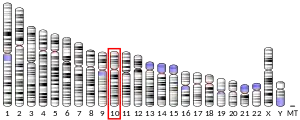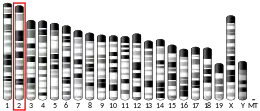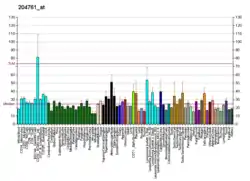USP6NL
USP6 N-terminal-like protein is a protein that in humans is encoded by the USP6NL gene.[5][6][7]
References
- GRCh38: Ensembl release 89: ENSG00000148429 - Ensembl, May 2017
- GRCm38: Ensembl release 89: ENSMUSG00000039046 - Ensembl, May 2017
- "Human PubMed Reference:". National Center for Biotechnology Information, U.S. National Library of Medicine.
- "Mouse PubMed Reference:". National Center for Biotechnology Information, U.S. National Library of Medicine.
- Matòsková B, Wong WT, Seki N, Nagase T, Nomura N, Robbins KC, Di Fiore PP (Jun 1996). "RN-tre identifies a family of tre-related proteins displaying a novel potential protein binding domain". Oncogene. 12 (12): 2563–71. PMID 8700515.
- Matòsková B, Wong WT, Nomura N, Robbins KC, Di Fiore PP (Jun 1996). "RN-tre specifically binds to the SH3 domain of eps8 with high affinity and confers growth advantage to NIH3T3 upon carboxy-terminal truncation". Oncogene. 12 (12): 2679–88. PMID 8700527.
- "Entrez Gene: USP6NL USP6 N-terminal like".
Further reading
- Nomura N, Miyajima N, Sazuka T, Tanaka A, Kawarabayasi Y, Sato S, Nagase T, Seki N, Ishikawa K, Tabata S (1995). "Prediction of the coding sequences of unidentified human genes. I. The coding sequences of 40 new genes (KIAA0001-KIAA0040) deduced by analysis of randomly sampled cDNA clones from human immature myeloid cell line KG-1". DNA Research. 1 (1): 27–35. doi:10.1093/dnares/1.1.27. PMID 7584026.
- Nomura N, Miyajima N, Sazuka T, Tanaka A, Kawarabayasi Y, Sato S, Nagase T, Seki N, Ishikawa K, Tabata S (1995). "Prediction of the coding sequences of unidentified human genes. I. The coding sequences of 40 new genes (KIAA0001-KIAA0040) deduced by analysis of randomly sampled cDNA clones from human immature myeloid cell line KG-1 (supplement)". DNA Research. 1 (1): 47–56. doi:10.1093/dnares/1.1.47. PMID 7584028.
- Hartley JL, Temple GF, Brasch MA (Nov 2000). "DNA cloning using in vitro site-specific recombination". Genome Research. 10 (11): 1788–95. doi:10.1101/gr.143000. PMC 310948. PMID 11076863.
- Lanzetti L, Rybin V, Malabarba MG, Christoforidis S, Scita G, Zerial M, Di Fiore PP (Nov 2000). "The Eps8 protein coordinates EGF receptor signalling through Rac and trafficking through Rab5". Nature. 408 (6810): 374–7. doi:10.1038/35042605. PMID 11099046. S2CID 4405293.
- Martinu L, Santiago-Walker A, Qi H, Chou MM (Dec 2002). "Endocytosis of epidermal growth factor receptor regulated by Grb2-mediated recruitment of the Rab5 GTPase-activating protein RN-tre". The Journal of Biological Chemistry. 277 (52): 50996–1002. doi:10.1074/jbc.M204869200. PMID 12399475.
- Brill LM, Salomon AR, Ficarro SB, Mukherji M, Stettler-Gill M, Peters EC (May 2004). "Robust phosphoproteomic profiling of tyrosine phosphorylation sites from human T cells using immobilized metal affinity chromatography and tandem mass spectrometry". Analytical Chemistry. 76 (10): 2763–72. doi:10.1021/ac035352d. PMID 15144186.
- Lanzetti L, Palamidessi A, Areces L, Scita G, Di Fiore PP (May 2004). "Rab5 is a signalling GTPase involved in actin remodelling by receptor tyrosine kinases". Nature. 429 (6989): 309–14. doi:10.1038/nature02542. PMID 15152255. S2CID 4431181.
- Wiemann S, Arlt D, Huber W, Wellenreuther R, Schleeger S, Mehrle A, Bechtel S, Sauermann M, Korf U, Pepperkok R, Sültmann H, Poustka A (Oct 2004). "From ORFeome to biology: a functional genomics pipeline". Genome Research. 14 (10B): 2136–44. doi:10.1101/gr.2576704. PMC 528930. PMID 15489336.
- Mehrle A, Rosenfelder H, Schupp I, del Val C, Arlt D, Hahne F, Bechtel S, Simpson J, Hofmann O, Hide W, Glatting KH, Huber W, Pepperkok R, Poustka A, Wiemann S (Jan 2006). "The LIFEdb database in 2006". Nucleic Acids Research. 34 (Database issue): D415-8. doi:10.1093/nar/gkj139. PMC 1347501. PMID 16381901.
- Olsen JV, Blagoev B, Gnad F, Macek B, Kumar C, Mortensen P, Mann M (Nov 2006). "Global, in vivo, and site-specific phosphorylation dynamics in signaling networks". Cell. 127 (3): 635–48. doi:10.1016/j.cell.2006.09.026. PMID 17081983. S2CID 7827573.
- Lanzetti L, Margaria V, Melander F, Virgili L, Lee MH, Bartek J, Jensen S (May 2007). "Regulation of the Rab5 GTPase-activating protein RN-tre by the dual specificity phosphatase Cdc14A in human cells". The Journal of Biological Chemistry. 282 (20): 15258–70. doi:10.1074/jbc.M700914200. PMID 17371873.
This article is issued from Wikipedia. The text is licensed under Creative Commons - Attribution - Sharealike. Additional terms may apply for the media files.




